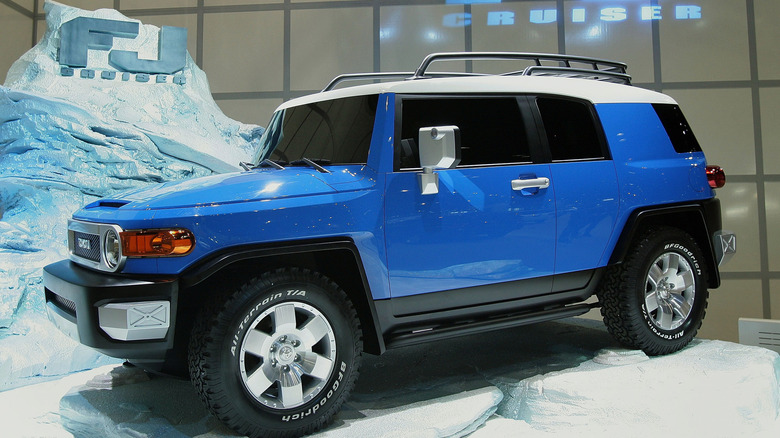The Pros And Cons Of Buying A Toyota FJ Cruiser
Though not as popular as its siblings under the Toyota Land Cruiser series, the FJ Cruiser managed to build a following when it was formally launched in 2006. However, despite being a very capable off-roader and having what seemed like a promising start on the market, its success was short-lived. The Japanese automaker discontinued the model in the U.S. in 2014, ultimately ending its worldwide production in 2017. Interestingly, the FJ Cruiser saw a spike in its demand as a collectible after its discontinuation.
The FJ Cruiser was first introduced as a retro concept car for the North American market in 2003. The vehicle was heavily inspired by the Land Cruiser model FJ40, which Toyota made from 1960 and 1984. Designed to be rugged, the FJ Cruiser debuted with a 4.0L V6 engine and a $21,710 introductory price. It took off among off-road enthusiasts. In its first year Toyota sold around 56,000 units annually. But sales quickly dropped. However, today, the FJ Cruiser is seeing a renewed interest from car enthusiasts, so demand is high.
If you're in the market for a used Toyota FJ Cruiser, finding a good deal might be a challenge. Depending on the year model, this mid-size SUV could fetch between $9,000 and $17,000. This range reflects only the base estimates for older models, so some dealerships may set a higher asking price for newer models or vehicles in mint condition, with higher trims, or those with aftermarket upgrades. Also, considering this is a discontinued model, you may want to look into its pros and cons first before making a purchase.
Pros: Design and performance
When it comes to design and performance, the FJ Cruiser is a strong choice in its market segment. From its high ground clearance to its body-on-frame construction, solid rear axle, locking differentials, and four-wheel drive system — everything about the vehicle makes it a capable off-roader. Toyota is renowned for its reliability, and the FJ Cruiser is a testament to that, with USA Direct Auto noting that owners have not reported major issues despite driving the Japanese SUV for hundreds of thousands of miles.
The car model's boxy shape, almost vertical windshield with three wipers, prominent grille with Toyota branding, and its notorious "suicide" doors give the FJ Cruiser character and distinction from the rest of the market, including its main rival, the Jeep Wrangler. Hence, buying one is like securing an attractive piece of Toyota's design history that will surely stand out in your garage, regardless if you are a collector or not.
The FJ Cruiser's interior design is a rugged five-seater. The water-resistant fabric seats are damage-proof against moisture. Also worth mentioning is the high-mounted driver seat that gives better visibility. Plus, the lack of high-end displays and entertainment features allow drivers to focus on the road and enjoy the ride while navigating bumpy roads.
In terms of safety, it's equipped with anti-lock brakes, stability controls, and plenty of airbags. Its high safety rating from the Insurance Institute for Highway Safety (IIHS) confirms its sturdy build, while the inclusion of a V6 engine means it is fun to drive even in rough of terrains. Overall, a used FJ Cruiser will be a good pick if you are after a hefty but easy-to-maneuver vehicle.
Cons: Fuel consumption and maintenance
The Toyota FJ Cruiser has downsides, and it's important to know them before buying. The most noteworthy is fuel efficiency. Since the vehicle runs on a 4.0L V6 gas engine, don't expect it to stretch a gallon of gasoline in the city or even outside of it. The average fuel consumption of a 2014 FJ Cruiser is 18 mpg combined city and highway, while the manual model average is 16 mpg. So if you are looking for a mid-size SUV with high fuel economy, then a used FJ Cruiser is not for you.
Parts and drive system-wise, this off-roader tends to suffer after hitting a certain mileage, ranging from easy-to-address to complicated. Consumer Reports has received several complaints regarding the FJ Cruiser's driveshaft or axle, electronic stability control, driveline vibration, differential transfer case, traction control, CV joint, electrical failure, and four-wheel-drive components. Other owners have also complained about premature wear and tear of pads and rotors, alongside braking system issues.
The fact that this is a discontinued model is a major disadvantage for long-term upkeep. The FJ Cruiser was discontinued in 2014, so it does not come equipped with more modern tech and safety features. Finding a unit in mint condition is a challenge. Even if you can find one in good condition, there's the possibility of needing repairs or maintenance to keep it running. In other words, owning an FJ Cruiser can be more expensive than just the vehicle's price tag.


